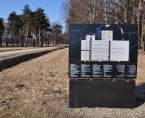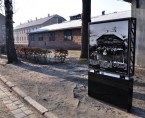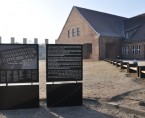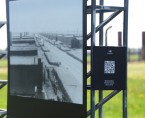Information plaques
System of historical plaques with historical information
The Memorial Site has a complex system of presentations of the former camp areas. Special plaques, placed in the most symbolic and important locations, describe and commemorate the most important venues and objects, as well as, the historical events related to them. They are in English, Hebrew and Polish languages.
The system of plaques include:
- general plan of the former camp;
- information explaining the most important buildings or sparticular events;
- documentary photographs, mostly of the so-called Lili Jacob Album, which shows the people that were deported to Birkenau. These are placed in the places in which they were taken;
- photographs taken illegally in the camp and reproductions of drawings made by the survivors;
- boards with aerial photographs made by the Allies in 1944 showing, among other things, the two parts of the camp, which are part of the Auschwitz-Birkenau Museum, and their immediate surroundings, together with the railway sidings by which the deportees were transported;
- plans and documentary photographs of individual sectors, placed at the entrances of individual sectors of the Auschwitz II-Birkenau camp;
- plans and photographs of the most important buildings of the camp;
- stones with the numbers of barracks in locations where the buildings have not survived and have only traces remaining;
and also:
- commemorative stones with the inscription: " To the memory of the men, woman and children who fell victim to the Nazi genocide. Here lie their ashes. May their souls rest in peace." These are situated next to the places of mass extermination and where the ashes of the murdered are located.
At several information boards at the former Auschwitz I and Auschwitz II-Birkenau QR codes were located which give access to testimonies of survivors who talk about events which took place at that particular location.
A vast majority of people come to understand the history of the Memorial Site in the company of specially trained guides that present information in nearly 20 languages. Nevertheless, very well presented system of commemorative plaques, combined with short multilingual information available within the area of the Museum, also provide an independent sightseeing.
The authors of the historical descriptions commemorating the areas of the former KL Auschwitz I and KL Auschwitz II-Birkenau are Museum specialists. Artistic design was created by: Prof. Barbara Borkowska and graphic artist Jacek Maria Stokłosa.









